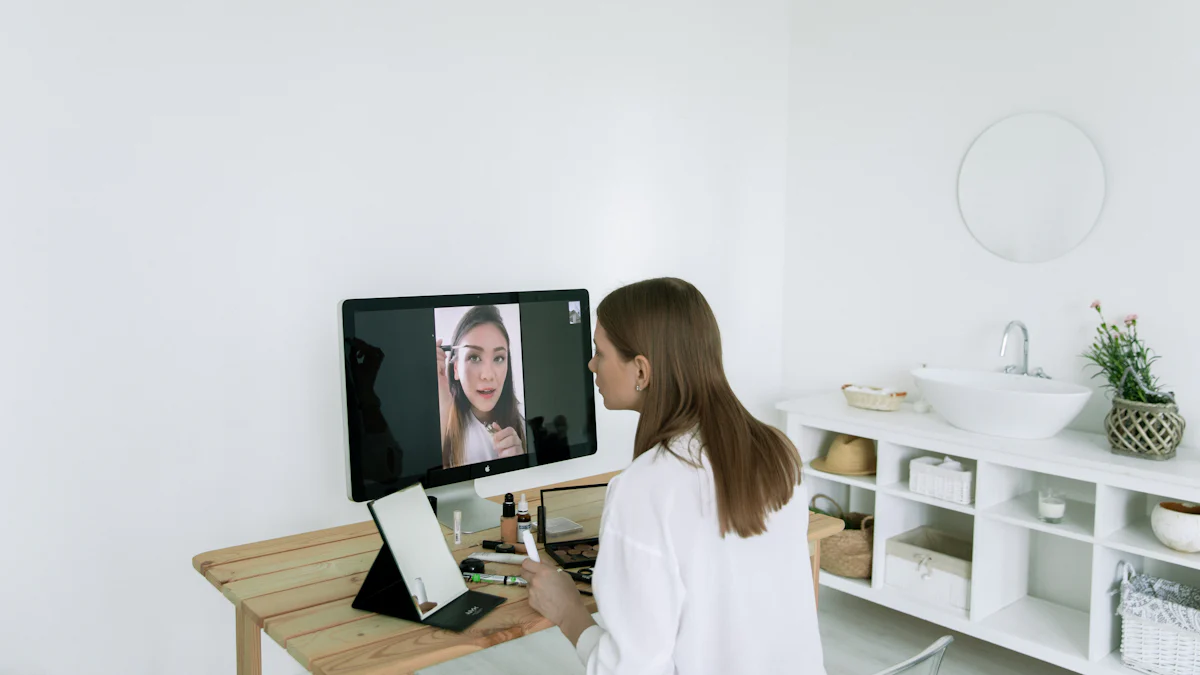Mastering Professional Speaking on Zoom

Mastering professional speaking on Zoom is crucial in today's digital age. With over 350 million daily meeting participants worldwide, Zoom has become a staple for both work and personal communication. Effective communication on this platform can significantly boost your career prospects. You might wonder how to sound professional on Zoom calls. Start by focusing on clarity and engagement. These skills not only enhance your presence but also help you stand out in meetings, paving the way for career advancement.
Key Takeaways
- Enhance clarity by practicing pronunciation and using simple, direct language to ensure your message is easily understood.
- Build confidence through thorough preparation and mindfulness techniques, which can help reduce anxiety before speaking.
- Engage your audience effectively by incorporating storytelling and encouraging interaction to create a more dynamic presentation.
- Optimize technical aspects by investing in quality audio equipment and ensuring proper lighting for a professional appearance.
- Utilize visual cues and gestures to maintain audience interest and convey your message more effectively during virtual meetings.
- Record and review your performance to identify strengths and areas for improvement, helping you refine your speaking skills over time.
Understanding the Challenges of Virtual Communication
Navigating virtual communication can feel like a maze. You might face unique challenges that don't exist in face-to-face interactions. Let's dive into some common hurdles and how you can overcome them.
Overcoming the Lack of Physical Presence
In a virtual setting, you miss out on the physical cues that help convey your message. Without body language, your words carry more weight. You need to be more expressive with your voice and facial expressions. This helps bridge the gap left by the absence of physical presence.
Consider using gestures that fit within the camera frame. They can add emphasis to your points. Also, maintain eye contact by looking directly at the camera. This creates a sense of connection with your audience. Remember, your enthusiasm and energy can make up for the lack of physical presence.
Managing Distractions and Technical Glitches
Distractions and technical glitches can disrupt the flow of your communication. You might find it hard to keep your audience engaged when these issues arise. To manage distractions, choose a quiet space for your meetings. Inform others in your household about your schedule to minimize interruptions.
Technical glitches are inevitable, but preparation can help. Test your equipment before the meeting. Ensure your internet connection is stable. Familiarize yourself with Zoom's features. This way, you can handle any hiccups smoothly. As the Virtual Teams Survey Report highlights, different leadership styles and decision-making methods can also pose challenges. Being prepared helps you navigate these complexities.
Adapting to Different Communication Styles
Virtual meetings bring together people with diverse communication styles. You might encounter varying levels of participation and decision-making approaches. Adapting to these differences is crucial. Listen actively and be open to different perspectives. This fosters a collaborative environment.
Encourage participation by asking open-ended questions. This invites others to share their thoughts. Be mindful of your tone and pace. Adjust them to suit the preferences of your audience. By doing so, you create an inclusive atmosphere where everyone feels heard.
Understanding these challenges and addressing them effectively can enhance your virtual communication skills. You'll find yourself more confident and capable in navigating the digital landscape.
Practical Tips for Improving Speaking Skills
Enhancing Clarity and Articulation
Clear and articulate speech is key to effective communication on Zoom. You want your audience to understand you without straining.
Practicing Pronunciation and Enunciation
Start by focusing on your pronunciation and enunciation. Practice speaking slowly and clearly. You can record yourself and listen to the playback. This helps you identify areas where you might mumble or rush through words. Try tongue twisters to improve your diction. They can be a fun way to enhance your clarity.
Using Simple and Direct Language
Use simple and direct language. Avoid jargon or complex words that might confuse your audience. Short sentences are easier to follow. They help keep your message clear and concise. Remember, the goal is to communicate effectively, not to impress with vocabulary.
Building Confidence and Reducing Anxiety
Confidence plays a huge role in how you present yourself. Feeling anxious can hinder your ability to communicate effectively.
Preparing Thoroughly for Meetings
Preparation is your best friend. Know your material inside out. This boosts your confidence and reduces anxiety. Create an outline of your key points. Practice delivering them until you feel comfortable. The more prepared you are, the more confident you'll feel.
Practicing Mindfulness and Breathing Techniques
Mindfulness and breathing techniques can help calm your nerves. Take deep breaths before you start speaking. Focus on your breathing to center yourself. This helps reduce anxiety and keeps you grounded. You can also try visualization techniques. Imagine yourself speaking confidently and engaging your audience.
Engaging Your Audience Effectively
Engagement is crucial for keeping your audience interested. You want them to feel involved and connected to your message.
Using Storytelling Techniques
Storytelling is a powerful tool. It makes your message relatable and memorable. Share personal anecdotes or examples to illustrate your points. This helps your audience connect with you on a personal level. Stories can make complex ideas more accessible and engaging.
Encouraging Interaction and Feedback
Encourage interaction and feedback. Ask open-ended questions to invite participation. This makes your audience feel valued and involved. Use polls or chat features to gather feedback. Respond to comments and questions promptly. This creates a dynamic and interactive environment.
By implementing these practical tips, you can enhance your speaking skills on Zoom. You'll find yourself communicating more clearly, confidently, and engagingly.
Technical Aspects of Professional Speaking on Zoom

Mastering the technical aspects of Zoom can elevate your professional speaking skills. Let's explore how to optimize your audio and camera presence to ensure you sound professional on Zoom calls.
Optimizing Audio Quality
Clear audio is crucial for effective communication. You want your audience to hear you without any distractions.
Choosing the Right Microphone
Invest in a good-quality microphone. It makes a significant difference in how you sound. Built-in laptop microphones often pick up background noise. A dedicated microphone provides clearer sound. Consider options like USB microphones or headsets with noise-canceling features. They enhance your voice clarity, making you sound professional on Zoom calls.
Adjusting Audio Settings
Before your meeting, check your audio settings. Ensure your microphone is selected as the input device. Adjust the volume to a comfortable level. Test your audio by recording a short clip. Listen to it and make necessary adjustments. This preparation ensures your voice comes through clearly during the call.
Enhancing Camera Presence
Your camera presence impacts how others perceive you. A professional appearance boosts your credibility.
Setting Up Proper Lighting
Good lighting enhances your video quality. Natural light works best. Position yourself facing a window. If natural light isn't available, use a ring light or desk lamp. Place it behind your camera to illuminate your face evenly. Avoid backlighting, which casts shadows and makes you appear dark.
Maintaining Eye Contact with the Camera
Eye contact creates a connection with your audience. Look directly at the camera when speaking. This simulates eye contact, making your interaction feel more personal. Avoid looking at your screen or notes too often. Practice this technique to make your Zoom calls more engaging and professional.
By focusing on these technical aspects, you can significantly improve how you sound professional on Zoom calls. Your audience will appreciate the clarity and professionalism you bring to each meeting.
Strategies for Maintaining Audience Engagement

Keeping your audience engaged during a Zoom meeting can be challenging. However, with the right strategies, you can capture their attention and make your presentation memorable. Let's explore some effective techniques.
Utilizing Visual Cues and Gestures
Visual cues and gestures play a vital role in virtual communication. They help convey your message more effectively and keep your audience interested. Use hand gestures to emphasize key points. Ensure your gestures are visible within the camera frame. This adds a dynamic element to your presentation.
Facial expressions also matter. Smile and show enthusiasm. Your energy can be contagious, encouraging your audience to stay engaged. Remember, your body language speaks volumes, even in a virtual setting.
Incorporating Interactive Elements
Interactive elements can transform a passive audience into active participants. Start by asking questions. Encourage your audience to share their thoughts. This creates a dialogue rather than a monologue.
Use Zoom's features to your advantage. Polls and quizzes can make your presentation more engaging. They provide instant feedback and keep your audience involved. Breakout rooms offer opportunities for small group discussions. These interactions foster a sense of community and collaboration.
Monitoring and Responding to Audience Reactions
Pay attention to your audience's reactions. Their body language and facial expressions can provide valuable feedback. Are they nodding in agreement? Do they look confused? Adjust your presentation accordingly.
Encourage feedback through chat or verbal comments. Acknowledge their input and respond promptly. This shows that you value their opinions and are open to discussion. By being responsive, you create a more interactive and engaging environment.
Incorporating these strategies can significantly enhance your audience engagement on Zoom. You'll find your meetings more lively and productive, leaving a lasting impression on your participants.
How to Sound Professional on Zoom Calls
Mastering how to sound professional on Zoom calls can elevate your virtual presence and make a lasting impression. Let's explore some effective strategies to enhance your communication skills during these meetings.
Recording and Reviewing Your Performance
Recording your Zoom meetings can be a game-changer. By reviewing your performance, you gain valuable insights into your speaking habits. You might notice areas where you tend to mumble or speak too quickly. This self-assessment helps you identify strengths and areas for improvement.
"The first week back, my voice was exhausted and completely in shock teaching my full schedule," shares a voice coach. This highlights the importance of understanding your vocal limits and making necessary adjustments.
After recording, take notes on what you did well and what needs work. Focus on clarity, pace, and engagement. This practice not only boosts your confidence but also refines your speaking skills over time.
Boosting Vocal Energy and Engagement
Vocal energy plays a crucial role in how you sound professional on Zoom calls. Treat each meeting as a performance. Your enthusiasm and energy can captivate your audience and keep them engaged.
To boost your vocal energy, warm up your voice before the call. Simple exercises like humming or lip trills can help. During the meeting, vary your pitch and tone to maintain interest. Avoid speaking in a monotone, as it can make your presentation dull.
"Even though you may not be teaching voice lessons all day – you are probably speaking all day into the Zoom machine," notes a public speaking coach. This emphasizes the need to manage your vocal energy effectively.
Maintaining a Conversational Tone
A conversational tone makes your Zoom calls feel more personal and engaging. It helps you connect with your audience on a deeper level. To achieve this, imagine you're speaking to a friend rather than a large group. Use simple language and avoid jargon.
Ask questions and encourage participation. This creates a dialogue rather than a monologue. Your audience will appreciate the interaction and feel more involved in the conversation.
Remember, mastering how to sound professional on Zoom calls involves practice and self-awareness. By recording your performance, boosting your vocal energy, and maintaining a conversational tone, you can enhance your virtual communication skills and leave a positive impression.
Mastering professional speaking skills on Zoom is essential in today's digital landscape. As Zoom continues to dominate both work and personal communication, your ability to communicate effectively can set you apart.
Here's a quick recap of the key strategies:
- Enhance Clarity: Focus on pronunciation and use simple language.
- Build Confidence: Prepare thoroughly and practice mindfulness.
- Engage Your Audience: Use storytelling and encourage interaction.
- Optimize Technical Aspects: Invest in good audio and lighting.
By implementing these techniques, you'll improve your virtual presence. Practice these tips in your next Zoom meeting and watch your communication skills soar.
FAQ
What is not flexible when using Zoom for business?
When using Zoom for business, safeguarding your reputation online remains non-negotiable. You must produce professional and effective engagements consistently. This means paying attention to your presentation, communication style, and technical setup to ensure you leave a positive impression.
Can I do public speaking on Zoom?
Absolutely! Zoom provides a platform for public speaking. You can reach a wide audience without geographical limitations. With the right preparation and techniques, you can deliver impactful speeches and presentations just as effectively as in-person.
How can I improve my speaking skills on Zoom?
Improving your speaking skills on Zoom involves practice and preparation. Focus on clarity and articulation by practicing pronunciation and using simple language. Build confidence through thorough preparation and mindfulness techniques. Engage your audience with storytelling and interactive elements.
What equipment do I need for professional Zoom calls?
For professional Zoom calls, invest in a good-quality microphone and proper lighting. A dedicated microphone enhances audio clarity, while good lighting improves video quality. These tools help you present yourself professionally and ensure your message is received clearly.
How do I maintain audience engagement during a Zoom meeting?
To keep your audience engaged, use visual cues and gestures. Incorporate interactive elements like polls and breakout rooms. Monitor audience reactions and respond to feedback promptly. These strategies create a dynamic and interactive environment that holds your audience's attention.
How can I sound more professional on Zoom calls?
Sounding professional on Zoom calls involves boosting vocal energy and maintaining a conversational tone. Treat each meeting as a performance and vary your pitch and tone. Record and review your performance to identify areas for improvement. This practice helps refine your speaking skills over time.
What should I do if I encounter technical glitches during a Zoom meeting?
Prepare for technical glitches by testing your equipment and ensuring a stable internet connection before the meeting. Familiarize yourself with Zoom's features to handle any issues smoothly. If glitches occur, stay calm and address them promptly to minimize disruptions.
How can I adapt to different communication styles in virtual meetings?
Adapting to different communication styles requires active listening and openness to diverse perspectives. Encourage participation by asking open-ended questions and adjusting your tone and pace to suit your audience. This fosters a collaborative and inclusive environment.
Why is eye contact important during Zoom calls?
Eye contact creates a connection with your audience. By looking directly at the camera, you simulate eye contact, making your interaction feel more personal. This technique enhances engagement and helps you build rapport with your audience.
How can I reduce anxiety before speaking on Zoom?
Reduce anxiety by preparing thoroughly and practicing mindfulness and breathing techniques. Take deep breaths before speaking and focus on your breathing to center yourself. Visualization techniques, like imagining yourself speaking confidently, can also help calm your nerves.
See Also
Perfecting Your Skills for Effective Hybrid Zoom Meetings
12 Creative Zoom Backgrounds to Enhance Your Online Meetings
4 Essential Factors to Weigh When Selecting Zoom or Google Meet
Best 4 Fall-Themed Virtual Backgrounds for Zoom Calls
A Comprehensive Guide to Mastering Computer Audio Visual Skills
